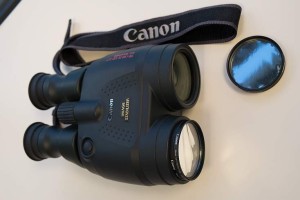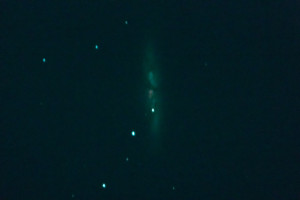I thought I’d make a post to show people the binoculars I use for observing sunspots. I have a pair of Canon 18×50 IS binoculars that I use almost exclusively for astronomical observing. These binoculars have 58mm filter threads which made it easy to take 4 58mm UV filters and some Baader Planetarium Solar Safety Film to make a little white light solar filter for each lens. I removed the retaining ring from two of the UV filters to extract the glass and cut Baader film for each. I then reassembled the UV filters. This leaves the film exposed to getting ripped or cut by physical contact, so I just screwed one of the unmodified UV filters to each of the modified filters to protect the film. The 58mm solar filters can be removed for night observing just by unscrewing them from the binos.
It would be lovely to have more than 18x magnification or to have a hydrogen alpha filter for viewing more details, but these binoculars are so easy to carry around and use, I find myself using them a lot. The 18x magnification is enough to that penumbra and umbra can be discerned on medium size or larger sunspots.
The Baader film works great. I’ve made filters for 4″ and 5″ telescopes out of it over the years. Last year I used one of those filters to take photos of the Venus transit of the Sun and a partial solar eclipse. They turned out pretty good. I’ll dig them up and post them soon.
Below is a photo of my binos with one of the solar filters removed.

